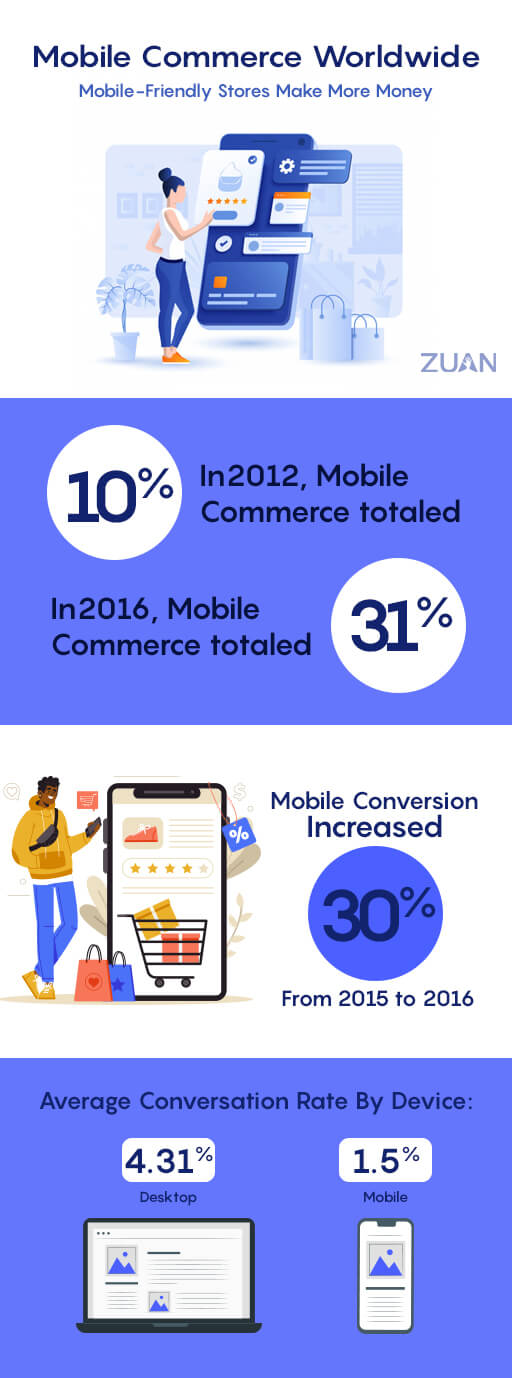
M-commerce is considered the most efficient way of transactions in modern life. This is convenient for businesses using a mobile application for shopping goods and services till payment of it.
M-commerce applications have now transformed into an essential part of the consumers in day-to-day life because of social media.
The focus and priorities of commerce are to integrate their services or improve their existing businesses.
Most important step for businesses working on mobile commerce app development and mobile websites for online stores, especially retail stores, is to stay competitive in the market.
What is M-commerce?
Mobile commerce, also known as (m-commerce or mcommerce), means a simple money transaction using mobile devices.
The advancement of eCommerce enables consumers to buy and sell goods or services using a mobile phone from anywhere at any time.
This technology growth triggered much new business owners, and services, to adapt to m-commerce and mobile shopping, including:
- Mobile money transfers.
- Electronic tickets and boarding pass.
- Digital content purchases and delivery.
- Mobile banking.
- Contactless payments and in-app payments.
- Location-based services.
- Mobile marketing, coupons, and loyalty cards.
Types of m-commerce services and applications
1. Finance and payments
This is the most efficient and widely used type of m-commerce service and application enabling users to the online shopping experience.
Nowadays mobile app payment is a common phenomenon from local supermarkets to international transactions.
For example, in Google Pay and Apple Pay, customers don’t need their wallet for payments – all their transactions are possible with their mobile technology.
But we can’t say that every individual adopted these payment options, but soon this will generalize and people will follow this norm more along with cash or credit cards in near future.
The finance institutions like credit unions and stockbrokers also must allow customers for account access, deposits, and transfer from their mobile apps.
For physical store businesses, it’s important to adopt m-commerce application checkouts in this digital era. On the other side, online businesses should definitely offer m-commerce application options for their clients.
2. Catalogs
M-commerce is transforming retail and wholesale businesses now. IKEA offers its customers a downloadable application that showcases the AR catalog with products and services for smartphone users.
Actually, this AR app is super efficient in that customers can visually decor their space with furniture and shop according to their interests. It comes with a hashtag, “try before you buy” sounds amazing right!
Customers are going ga-ga over this technology, as it helps to get a better idea of a product. This also reduces the time of refurbishment and the rate of returns for businesses.
This helps businesses to improve user engagement and also increases their revenue.
3. Marketing
M-commerce helps different types of services and applications to multiply their brand awareness with marketing tools.
Few businesses that profit from this option is a bookstore and fast-food restaurant.
Location-based mobile marketing is a tool that helps businesses to reach their customers in a nearby physical location.
You can use SMS apps to send coupons or use the brand app to promote a flash sale or in-store discount, all these marketing strategies can be implemented with your m-commerce app.
4. Tickets and entertainment
You can’t deny if I say, mobile phones are the key to your world. Yes, it’s possible to unlock your front door with mobile apps.
There are wi-fi or date enabled door locks so famous nowadays. One can use it as a pass for flight bookings and live concert tickets.
All these advancements are convenient for customers and reduce the impact on the environment, which additionally boosts your brand name.
5. Entertainment and games
Games are loved by adults over children these days, everyone knows that games like Pokemon Go and Harry Potter changed mobile entertainment completely.
Here comes the ease of an augmented-reality landscape, that fascinates more customers to try out all those games.
These games help people to engage with unmet pop cultures and interest users to participate socially with other fans in the universe.
Game developers got huge opportunities for monetizing their apps, they can opt for in-app purchases or by selling advertisements.
6. Online Grocery Shopping
Online Grocery shopping has become the most revolutionary m-commerce services and applications.
Moreover, Online grocery m-commerce apps like Bigbasket and RedSeer say they will grow by (55% to 1.2%) with Grocery apps.
It helps customers to buy groceries at their convenience easily. They can also pay online and even delivery is available at the doorstep.
In India apps like BigBasket and Jiomart and etc are anticipated to get an annual growth rate (CAGR) of 68.66% in (2018-2023) and reach a rate of INR 1,034 Billion in 2023, from its previous value of INR 62 Billion in 2018.
Online Grocery apps enable customers to buy products using mobile devices or laptops easily. They can also subscribe to monthly refills and get additional discounts on purchases.
Indians do shopping on online channels, just because there are abundant physical grocery stores available in the country.
There are also other e-commerce platforms that allow people to shop for groceries.
For example, Amazon, Flipkart, Reliance fresh, Grocers, BigBasket and Jiomart, etc.
With these mobile apps, people now don’t have to wait in long queues and bargain.
As there are multiple options that save all their effort and time spending on Grocery shopping.
M-commerce Statistics
So, now you know that mobile commerce is important for businesses irrespective of their field.
Let’s look at the numbers, to know about the benefits of a mobile-first m-commerce strategy.
“M-eCommerce sales are expected to rise 54% of the total ecommerce growth rate by 2021”.
Here’s the complete m-commerce infographic for you:

Mobile device differences
- iOS users spend 18% more than Android users.
- Desktop average order value (AOV) – 53% more than mobile AOV (iOS + Android).
Desktop still matters
- Desktop AOV is 50+% more than mobile AOV.
- Average conversion rate by device,
- Desktop: 4.31%
- Mobile: 1.5%.
Winding-up
To increase revenue and business growth using m-commerce services and applications, I suggest having native brand apps for transactions.
In this competitive world, in-store commerce markets such as grocery stores must include mobile payment options. This will eventually help businesses to offer a great user experience.
You can use an app building platform such as Magento Mobile App Builder to develop a mobile application or any other types of m-commerce services and applications.
The ideal way to grow business and additional revenue are possible by finding the best m-commerce niche.
This helps businesses to stay connected with customers and continue growing profits more than ever.
Say Yes to Technology advancements & keep growing!

